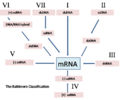Virus classification facts for kids
Virus classification is how scientists organize and group different kinds of viruses. There are many types of viruses in the world. Scientists classify them to make it easier to study and understand them. This grouping also helps them remember viruses and the diseases they cause. The International Committee of Taxonomy of Viruses (ICTV) is the main group in charge of virus classification.
Scientists look for common features when classifying viruses. For example, they check if a virus is made of DNA and protein, or RNA and protein. They also consider the virus's size, shape, and the illnesses it causes.
How Scientists Group Viruses
Similar viruses are first placed into larger groups called "families." Each family has a special name that always ends with "-viridae." For instance, rotaviruses belong to the Reoviridae family. Also, herpes viruses are part of the Herpesviridae family.
Viruses within a family that are very much alike are then put into a smaller group. This smaller group is called a "genus."
What is Baltimore Classification?
Another way to classify viruses is called the Baltimore Classification. This method is different from the ICTV system. Some scientists prefer the Baltimore Classification because it groups viruses based on how they grow inside cells. It looks at how viruses make their genetic material work.
Images for kids
-
The Baltimore Classification of viruses is based on the method of viral mRNA synthesis
See also
 In Spanish: Clasificación de los virus para niños
In Spanish: Clasificación de los virus para niños


